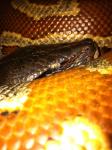» Site Navigation

2 members and 697 guests
Most users ever online was 47,180, 07-16-2025 at 05:30 PM.
» Today's Birthdays

» Stats

Members: 75,905
Threads: 249,105
Posts: 2,572,113
Top Poster: JLC (31,651)
|
-
Registered User


Steve Roussis went on to breed his superball back to a ball and made a 75% what he called a "Mongrel Ball". These were even more difficult to distinguish from a normal ball. Sadly enough he peddled them off to the general public where I am sure their sullied genetics reside in many of your designer ball morphs.
As was brought up in a previous post, the Morelia community has been sour on the Diamond python for years now. Diamonds were once the trophy of the morelia world and by any sense should be more popular than carpets ever had become. When they first became available, they were naturally expensive, so lazy curious breeders who could only afford one decided to cross it with a carpet to make a 50%, then back to the parent and so on to the point where they ALMOST looked like diamonds again. Well you cant take the coffee out of the milk, so nobody trusted Diamonds anymore, especially with a closed Aussie market. Diamonds are still expensive and no one is willing to invest in a suspect project. This also left an impact on the Aussie gov't in that it has always been an argument by US keepers and importers that Australia should loosen their export laws to enable more "insurance" populations of pure Australian animals outside of Australia.
Anyway, making Frankensnakes is not usually as easy and clean cut as putting a pair together. It still may require two 1.1 pairs to get things churning. It usually involves stimulating a female with a male of the same species with a taped or glued cloaca so no "normal" breeding occurs, as well as extracting scent from the other female and smearing it on the muttmaker female. Then if the desired pair is hot n heavy, put them together and hope for the best. Its not over yet, get ready for a good percentage of grossly deformed full term monsters that inevitably comes with crossing two morphologically different species of different sizes. The ones that appear to be outwardly healthy stand a good shot at having distended organs, inappropriate sized brain cases, etc. 
-
 Posting Permissions
Posting Permissions
- You may not post new threads
- You may not post replies
- You may not post attachments
- You may not edit your posts
-
Forum Rules
|










